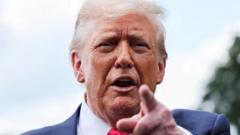A major change in U.S. military aid to Ukraine is underway as former President Trump proposes a new strategy to supply weapons through NATO allies rather than directly from U.S. stockpiles.
New Military Aid Strategy for Ukraine Emerges Amid Ongoing Conflict

New Military Aid Strategy for Ukraine Emerges Amid Ongoing Conflict
Former President Trump Announces Shift in U.S. Arms Supply Tactics to Ukraine by Selling to NATO Allies
In a significant shift regarding military assistance to Ukraine, former President Donald Trump recently announced plans to supply weapons to NATO nations, which would in turn funnel those arms to Ukraine in its ongoing conflict against Russian forces. This declaration came after Trump returned to office with an apparent change in stance on Ukraine, shifting from previous hostility toward the country's leaders to a more supportive role in terms of military aid.
Historically, the U.S. has provided extensive military support to Ukraine. Abundant aid began under former President Barack Obama after Russia's initial aggression in 2014, leading to a rise in lethal assistance during Trump's presidency starting in 2017, when Kyiv received weapons like the Javelin antitank missiles. Further backing surged post-2022 invasion, with the Biden administration committing around $67 billion in various military assistance forms.
The current method of U.S. assistance has been twofold: immediate weapons transfers via the presidential drawdown authority for urgent needs and the Ukraine Security Assistance Initiative, which allows for longer-term purchases directly from American defense suppliers.
Trump's recent proposal introduces a different avenue by suggesting direct sales to European nations, which he claims would streamline the process of supplying Ukraine. This approach aims to bolster the Ukrainian defense against the ongoing Russian offensive while potentially aiding European nations in replenishing their own military stockpiles.
Despite the extensive military aid already provided, Ukraine's urgent need for specific types of weaponry, particularly air-defense systems, remains critical. With the ongoing dependence on Soviet-era arms systems, the U.S. response has included refurbishing and supplying older models to meet current needs.
The political landscape remains complex, with potential implications for NATO's collective defense initiatives and how the U.S. collaborates with allies amid shifting presidential dynamics. This ongoing situation underscores a pivotal moment in military strategy and international relations as Ukraine battles for sovereignty against Russian incursions.
As discussions continue and more information emerges, experts remain watchful of the evolving arms dynamics and their impacts on the conflict's trajectory in the months to come.
Historically, the U.S. has provided extensive military support to Ukraine. Abundant aid began under former President Barack Obama after Russia's initial aggression in 2014, leading to a rise in lethal assistance during Trump's presidency starting in 2017, when Kyiv received weapons like the Javelin antitank missiles. Further backing surged post-2022 invasion, with the Biden administration committing around $67 billion in various military assistance forms.
The current method of U.S. assistance has been twofold: immediate weapons transfers via the presidential drawdown authority for urgent needs and the Ukraine Security Assistance Initiative, which allows for longer-term purchases directly from American defense suppliers.
Trump's recent proposal introduces a different avenue by suggesting direct sales to European nations, which he claims would streamline the process of supplying Ukraine. This approach aims to bolster the Ukrainian defense against the ongoing Russian offensive while potentially aiding European nations in replenishing their own military stockpiles.
Despite the extensive military aid already provided, Ukraine's urgent need for specific types of weaponry, particularly air-defense systems, remains critical. With the ongoing dependence on Soviet-era arms systems, the U.S. response has included refurbishing and supplying older models to meet current needs.
The political landscape remains complex, with potential implications for NATO's collective defense initiatives and how the U.S. collaborates with allies amid shifting presidential dynamics. This ongoing situation underscores a pivotal moment in military strategy and international relations as Ukraine battles for sovereignty against Russian incursions.
As discussions continue and more information emerges, experts remain watchful of the evolving arms dynamics and their impacts on the conflict's trajectory in the months to come.





















